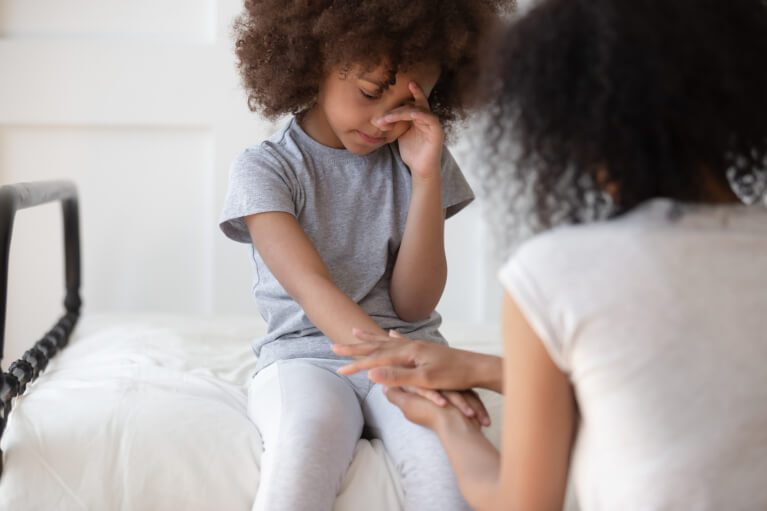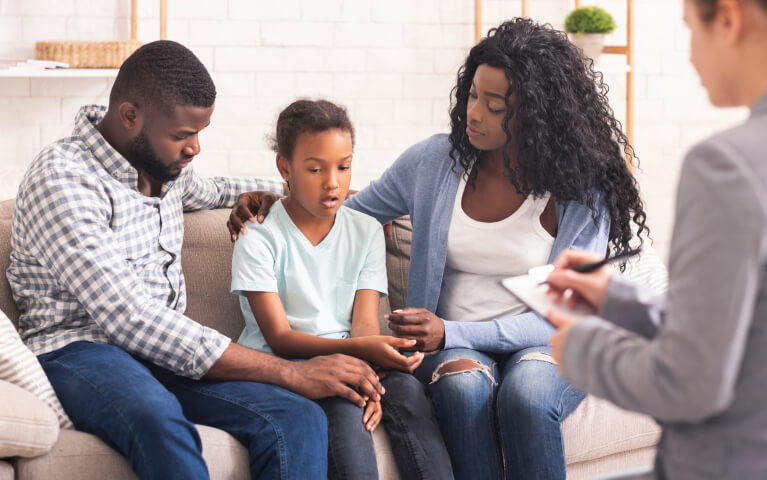A Parenting Guide to Divorce: Tips to Reduce the Strain on You and Your Child

Introduction to Our Family Divorce Guide
With about half of all marriages ending in divorce, many parents will go their separate ways before their children reach age 18. Going through a divorce with children presents unique challenges, and it can take an emotional toll on everyone involved.
However, this toll is often different for parents and children. While it is common for parents to feel stressed and overwhelmed, children often experience feelings of confusion, sadness, uncertainty and even fear about what the future may hold. Even older children are not likely to fully understand what it means for their parents to get divorced; and, regardless of what their parents say, many children will find it difficult not to blame themselves – at least in some respect – for their parents’ decision to bring their marriage to an end.
As a parent, talking to your child about your impending divorce can be difficult, but it is important. Letting your children know how your divorce will and won’t change their lives, what they can expect during the process, and that your decision has nothing to do with anything they may have said or done can go a very long way toward easing the emotional burden. It is also important to listen, and to be aware of the signs that your child may be reacting adversely, as doing so will allow you to help them manage their feelings along the way.
Download and print these resources created for this guide:
Approaching Divorce with Children: A Breakdown Based on Ages

Children of different ages will respond to their parents’ divorces differently. This is because children respond to information and stressors differently at different stages of development. Generally speaking, the older a child is, the better able he or she will be to comprehend the practicalities of a divorce (i.e. the parents living in different households and spending time separately with each parent); however, children of all ages will still generally struggle to fully internalize the impacts of their parents’ divorce and to express their concerns and feelings effectively.
With this in mind, parents must approach talking with their children with an awareness of the specific considerations that are relevant to their children’s current stage of cognitive development. Here is a breakdown of some of the most-important factors and some tips for communicating with children based on their age. Of course, all children will have their own unique response; and, rather than rigidly following any set of general guidelines, parents should tailor their approach based on what they believe will be most effective and most beneficial for their own children:
How Children Respond to the Effects of Divorce, and What Parents Can Do to Help Their Children
1. Infants (Newborn to Approximately Two Years Old)
Even though newborns may be unable to communicate, they can still sense conflict, and this can affect their mood while also potentially impacting their development. As explained in an article on Parents.com, “[B]abies are able to feel tension . . . between their parents . . . but can’t understand the reasoning behind the conflict. . . . [B]abies may become irritable and clingy, especially around new people, and have frequent emotional outbursts. They may also tend to regress or show signs of developmental delay.”
In order to prevent their divorce from negatively impacting their infant children, the article recommends that parents focus on familiarity and stability. This includes, “maintain[ing] normal daily routines, particularly regarding sleep and meals,” and spending as much time with infants as possible. Additionally, even though infants may not be able to understand what their parents are saying, parents should still avoid getting into heated discussions or having arguments in front of their children.
2. Toddlers (Approximately Ages Two to Three)
As children progress into toddlerhood, tension and disruptions are more likely to cause confusion. Children in this age group simply won’t understand what is happening—all they will know is that their parents seem upset, and it will be natural for them to assume that they are directly involved. When faced with uncertainty, toddlers will often show signs of regression, and they may develop a tendency to lash out while also seeking more contact and attention.
At this age, parents can – and generally should – talk to their children about their divorce, but they should be sure to do so in terms their children can understand. Speaking over their heads will only add to their confusion and feelings of isolation. Spending as much time together as possible is important at this age as well (and this will be a theme throughout this discussion), as is maintaining a routine that is centered around the children’s needs.
3. Preschoolers and Kindergartners (Approximately Ages Four to Six)
“Preschoolers need simple, concrete explanations,” explains an article in Today’s Parent. With this in mind, when discussing their divorce with their children in this age group, parent should, “[s]tick to the basics: which parent will be moving out, where the child will live, who will look after [the child] and how often [the child will] see the other parent.” Parents should also be prepared for lots of questions, and they should be prepared to provide real answers that directly address their children’s concerns.
Additionally, as noted by Parents.com, “Like toddlers, preschoolers believe they are ultimately responsible for their parents’ separation.” No matter how much their parents explain, preschoolers and kindergartners are going to struggle to understand how and why their lives are going to change in a way that they never previously thought possible. Anger, uncertainty as to how to react, anxiety, and sadness are all common feelings, and helping children express these feelings can be an important step toward helping them cope generally with their parents’ divorce.
4. Young School Age (Approximately Ages Seven to Eleven)
Children between the ages of approximately seven and eleven will generally have a better understanding of their own feelings, and this means that they are likely to be hit harder by their parents’ divorce. Many children will feel as though they are being abandoned, or that they will be abandoned once their parents go their separate ways. For this reason, it is also common for children in this age group to feel a desire to try to prevent the divorce and preserve their family unit.
It is also in this age range, usually on the higher end, that some children will begin to take sides. They may have a stronger emotional connection to one parent, and this may lead them to blame the other. As a result, not only is it important that parents communicate with their children about their divorce and the divorce process, but it is also important for both parents to avoid blaming one another or helping to foster feelings of ill-will. No matter how the parents feel about one another, they should not under any circumstances try to get their children “on their side,” as this has been shown to have not only severe detrimental impacts on children’s emotional stability, but to have a negative impact on the children’s ability to adjust to post-divorce life as well.
5. Pre-Teen and Teen (Ages 12 and Older)
The pre-teen and teen years can be among the most-confusing of any child’s life—and this is true before they learn that their parents have decided to get divorced. Children ages 12 and older are even more likely than their younger siblings to cast blame, whether on themselves or on one or both of their parents. At this age, a divorce may also lead children to question their parents’ authority, and that of their non-custodial parent post-divorce in particular, and they are also much more likely to pick a side during the divorce process. However, this will not invariably be the case, and some pre-teens and teens will react to their parents’ divorce by becoming withdrawn or acting out, and it also is not uncommon to see signs of anxiety and depression.
According to Todays’ Parent, for children in this age group, “[k]eeping communication open decreases the chance that emotional problems [will] slip under the radar. Kids in this age group can be harder to reach, . . . [b]ut most teens and preteens still need and crave connection with [their] parents.” Even if a child acts disinterested or rebukes his or her parents’ efforts to discuss their divorce, it is still very important for parents to make the effort to explain their family’s situation and share as much pertinent information as they can so that their children know they are not being ignored.
Warning Signs that Tension at Home Due to an Impending Divorce May Be Getting to Your Children

Given the wide range of emotions that children in different age groups can experience upon learning of their parents’ decision to get divorced, it is important for parents to be aware of the warning signs that their children may be harboring feelings internally—whether intentionally or not. If parents have concerns, they should speak with their children to provide information and guidance, and they should consult with appropriate professionals as and when necessary.
Some of the more common signs that children may be struggling emotionally as a result of their parents’ impending divorce include:
- Infants (Newborn to Approximately Two Years Old) – Among infants, signs that they may be internalizing tension in the home include increased irritability, emotional outbursts, developmental regression or delays, and being more clingy than usual.
- Toddlers (Approximately Ages Two to Three) – For toddlers who can begin to understand that one of their parents is leaving but who still lack the ability to comprehend other aspects of their parents’ divorce, warning signs may include crying or seeking attention more frequently than usual, developmental regression or delays, and waking up more frequently in the night.
- Preschoolers and Kindergartners (Approximately Ages Four to Six) – Children in this age group will often respond to news of their parents’ divorce by regressing in their emotional independence, by having outbursts, and by exhibiting signs of worry or frustration due to their inability to change the situation at hand.
- Young School Age (Approximately Ages Seven to Eleven) – Again, for children in this age group, one of the biggest concerns is often their fear of abandonment. Parents should monitor for signs of fear and anxiety, as well as signs of depression and withdrawal. Some children in this age group will experience physical symptoms of stress as well.
- Pre-Teen and Teen (Ages 12 and Older) – For pre-teens and teens, the warning signs that they may be responding negatively to their parents’ divorce can include any of the above. Pre-teens and teens may also attempt to “test” their parents to either confirm or disaffirm their concerns about being abandoned post-divorce.
Divorce Checklist for Parents

As a parent preparing to go through a divorce, reducing uncertainty for yourself is key to helping you reduce uncertainty for your child. The more you (and your spouse) can do to plan ahead – and the more decisions you can make amicably before you inform your children of your decision to get divorced – the smoother the process is likely to go.
When it comes to helping their children cope with their divorce, one of the keys for parents is to minimize conflict, both in and outside of the home. Children who see their parents fighting or who can sense tension between their parents are far more likely to have concerns about what they can expect once the process is over. In order to reduce conflict, parents should try to have open and honest discussions (outside of their children’s presence), and they should structure these discussions in order to ensure that they are as productive as possible.
The following checklist can be used by all parents who are considering a divorce. Whether you and your spouse each plan to follow a traditional court based approach, use a collaborative divorce process, or you are planning to work with a mediator, these are questions you and your spouse will need to address, and it typically will be most beneficial to do so sooner rather than later:
1. Which Type of Custody Arrangement Will You Use?
Today, parents have a number of different options when it comes to child custody arrangements. While more traditional custody and visitation schedules are still an option (i.e. with one parent having primary custody and the other having visitation rights every other weekend), parents are choosing alternatives such as equal parenting time and even co-parenting with increasing frequency.
2. How Will You Structure Your Parenting Time Schedule?
Regardless of the type of custody arrangement you and your spouse choose, you will need to come up with a parenting time schedule that works for both of you. This schedule should be detailed, but not so much so that it eliminates necessary flexibility. The more you and your spouse can do to provide stability and structure after your divorce, the easier the transition will be for your children.
3. How Will You Handle Birthdays, Holidays and Vacations?
In addition to your day-to-day parenting time schedule, it is important to think about how you and your spouse will handle birthdays, holidays and vacations as well. Unless you are co-parenting, you will most likely be celebrating and traveling with your children separately, and you will need to make special provisions to account for this in your parenting plan. For example, on Thanksgiving, will your children spend half of the day with each of you, will your child spend Thursday with you and Friday with your former spouse, or will you alternate years?
4. How Will You Handle Transportation Between Homes and Activities?
One aspect of post-divorce parenting that many parents fail to consider is transportation. Most parents think about scheduling, but the matter of getting from one scheduled event or visit to the next often gets overlooked. In order to make sure that each parent knows their respective transportation responsibilities (and so that children know they will always get picked up or dropped off on time), parents should address this in their post-divorce parenting plan as well.
5. How Will You Make Decisions about Things Like Extracurricular Activities and Healthcare?
No matter how much forethought you give to planning for post-divorce life, you cannot make decisions about everything in advance. If your child wants to sign up for an extracurricular activity in the future, who will decide if this is okay? If your child has a medical emergency, how will you and your former spouse make decisions, and how will you cover the costs involved? These are just two examples of many similar types of issues that parents will want to proactively address during the divorce process.
6. What Rules Will You Both Enforce After Your Divorce?
Another important aspect of stability during childhood is rule enforcement. Generally speaking, both parents should enforce the same rules equally so that their children do not develop favoritism. During the divorce process, parents should decide what rules they will enforce, and how, and they should also address the inevitable need to adopt new rules in the future.
7. What Will You Do to Make Sure Both Parents Contribute to Your Child’s College Savings?
Generally speaking, college savings is not covered under the umbrella of child support. Child support is intended to meet children’s basic needs until they reach adulthood, or into early adulthood in certain limited circumstances. As a result, parents must address college savings as a discrete issue during their divorce, and they must agree on a plan that they can both enforce if necessary.
8. Where Will Your Children’s Belongings “Live”?
From clothes to bikes and skateboards, when going through a divorce parents will need to decide where their children’s belongings are going to “live.” This is especially important in shared parenting (50-50 parenting time split) and co-parenting arrangements, in which a child’s life can feel too transitory if he or she is packing and unpacking on a weekly or daily basis. While it may make sense for parents to double up on certain items, in most cases children’s belongings will be divided between the parents’ households in some fashion.
9. Will Both Parents Attend Games, Recitals, Graduations and Other Events?
After a divorce, both parents will often want to attend events like games, recitals and graduations, but children may feel awkward, uncomfortable or embarrassed if their parents come, sit and leave separately. Parents should have a plan for this as well, and this is one area in particular where it may make sense to seek children’s input, especially in the pre-teen and teen years.
10. How Will You Resolve Any Disagreements that Arise After Your Divorce?
If you and your former spouse reach a disagreement during your post-divorce life, how will you resolve it? Avoiding conflict post-divorce is important as well, particularly when the decisions you and your former spouse need to make impact your children.
Your Child’s Role in the Divorce Proceedings

Getting divorced is a process, and the length and complexity of the process depend on a variety of different factors that are unique to each family. These factors include the number of children involved, the age of each child, and the parents’ ability to make amicable decisions in their children’s best interests.
Generally speaking, while parents should carefully consider their children’s needs and wants, they should not involve their children in the divorce process directly. However, there are a few exceptions—including circumstances in which the child is mature enough to make a reasoned request regarding his or her preferences regarding child custody.
Establishing Parenting Time in a Divorce – The “Best Interests” Factors for Child Custody
In Washington and other states, the law requires that all child custody-related decisions be made based on the best interests of the children involved. Washington, like other states, has established a statutory list of “best interests” factors, and these factors should guide parents’ decision-making with regard to child custody during the divorce process. These factors include:
- The strength and stability of the child’s relationship with each parent;
- The parents’ agreement regarding parenting time;
- Each parent’s history of parental involvement and capacity for parenting post-divorce, “including whether a parent has taken greater responsibility for performing parenting functions relating to the daily needs of the child;”
- The child’s current stage of cognitive development and emotional needs;
- The child’s relationships with siblings and with other significant adults
- The child’s involvement with school and other activities;
- The child’s wishes if he or she is, “sufficiently mature to express reasoned and independent preferences as to his or her residential schedule;” and
- The parents’ respective employment schedules.
Importantly, Washington law provides that the first factor in this list—the strength and stability of the child’s relationship with each parent—must “be given the greatest weight.” When parents’ intention is for their children to split time between two different households, the geographic proximity of the parents’ homes is a factor that must be considered as well.
When (and How) Should Parents Consider Their Children’s Wishes Regarding Post-Divorce Custody?
Parents’ decisions regarding custody obviously have a direct and substantial impact on their children; and, whether they say so or not, most children will have preferences regarding where they will live after their parents’ divorce (even if these preferences are not particularly sound or well-formed). Generally speaking, however, parents should avoid asking their children for input, as this is only likely to lead to additional uncertainty and confusion for the child, and any decisions that do not reflect the child’s wishes may lead to resentment.
But, in Washington and many other states, the “best interests” factors account for consideration of the child’s wishes in some cases. As in Washington, this is usually tied to the child’s ability to make a reasoned decision—and this is at least indirectly tied to the child’s age.
Even in circumstances in which parents decide to ask their children about their preferences, parents should generally seek professional guidance prior to doing so. Which parent (or parents) present the question, how the question is presented, and what options are offered are all decisions that require careful forethought and consideration. In all circumstances, parents should make clear that the child’s preference is not the sole determining factor, and parents should anticipate their children’s possible answers and decide how they will respond in advance.
Addressing Child Support and Other Financial Considerations During the Divorce Process
When it comes to reducing strain post-divorce, the importance of financial planning cannot be overlooked. This includes not only addressing child support, but addressing college expenses (as discussed above) and other costs as well.
Most, if not all states, have statutory guidelines for establishing child support payments during a divorce. In Washington, divorcing parents use a worksheet provided by the courts, and they can follow a detailed set of instructions to determine which parent is obligated to pay and how much he or she will owe. This worksheet establishes the “basic” child support amount; and, if parents have other expenses to divide (i.e. child care or health insurance), then the parents will divide these expenses proportionally based upon their “basic” child support calculation.
After the Divorce: Advice for Co-Parenting & Keeping the Peace

While the divorce process takes time, eventually, the process will be over. When it is, this is when reality sets in for most children, and this is when parents learn how effectively they have addressed and managed all of the various aspects of dividing their household and bringing their marriage to an end.
Importantly, while it is possible to modify certain aspects of a divorce in some cases, parents should generally consider the terms of their divorce final—especially in the short term. But, with a comprehensive and mutually-agreeable parenting plan in place, divorced parents (and their children) will usually be able to settle into their new lives with a solid foundation and minimal risk of conflict.
Adjusting to post-divorce life can be very different for parents who establish joint custody arrangements and for those who choose to co-parent. Here are some tips for parenting after a divorce in each scenario:
Tips for Parents Who Will Share Joint Custody After Their Divorce
If you will be splitting parenting time with your former spouse after your divorce, it will be important to:
1. Make Sure You Know the Terms of Your Divorce
You worked hard to arrive at a workable parenting plan, so make sure you use it. Stick to your plan, and try to avoid miscues or oversights that could lead to issues with your former spouse.
2. Make a Commitment to Communicate Amicably
You will still need to communicate with your former spouse about various issues. To minimize the likelihood of confrontations, make a commitment to always communicate amicably, and never discuss potentially-heated issues while your children are around.
3. If an Issue Comes Up, Address it Proactively
If you run into an issue, do not let it linger. Lingering issues usually get worse over time, and waiting can make it harder to find a mutually-agreeable solution.
4. Keep Your Children’s Interests First
Your children will continue to feel the effects of your divorce long after it is over. As you move on, keep your children’s interests first, and continue to monitor for signs of adverse emotional effects.
5. If You Need to Make a Change, Seek Help First
If circumstances change and your parenting plan no longer works, hire an attorney to help you request a modification before you do anything inconsistent with your plan.
Tips for Parents Who Will Be Co-Parenting After Their Divorce

If you and your former spouse will be co-parenting after your divorce, these tips will help you, your former spouse, and your children adjust to your new post-divorce life:
1. Make Sure Your Children Understand Their Situation
Co-parenting can be confusing for children who have just seen their parents go through a divorce. Make sure they understand their situation, and explain how things will be different (and similar) going forward.
2. Emphasize Open and Honest Communication
Making co-parenting work is all about communicating effectively. You and your co-parent will need to talk on a regular basis, and it will be important to make sure you are always cordial and cooperative in front of your children.
3. Don’t Ignore Your Own Personal Needs
Co-parenting can be stressful, especially in the immediate aftermath of your divorce. While your children need to come first, you need to take care of your own personal needs as well.
4. Err On the Side of Mutual Benefit
When in doubt, err on the side of doing what is best for you, your former spouse, and your children. For co-parenting to work, both parents need to be committed to the arrangement’s success.
5. If Something Isn’t Working, Talk About It
Finally, if something isn’t working for you, or if things aren’t going quite how you expected, talk about it. Just like joint custody arrangements, letting issues linger can lead to bigger problems, while being proactive can reduce stress and alleviate uncertainty for everyone involved.
Additional Resources for Divorced Parents
- Psychological Effects of Divorce on Children: https://www.verywellfamily.com/psychological-effects-of-divorce-on-kids-4140170
- Helping Children Through a Divorce: https://kidshealth.org/en/parents/help-child-divorce.html
- Co-Parenting Tips for Divorced and Separated Families: https://www.survivedivorce.com/co-parenting-tips
- Making Stepfamilies Work: https://www.apa.org/topics/stepfamily
- Custody & Parenting FAQ: https://seattledivorceservices.com/resources/qa/custody-parenting/
